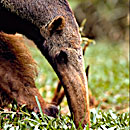Giant Anteater (Myrmecophaga tridactyla) Classification: Class: Mammalia, Order: Xenarthra, Family: Myrmecophagidae, Genus: Myrmecophaga, Species: maximus IUCN Status: Vulnerable
| |
 |
One thing that makes Giant Anteaters unique is that their head/mouth segments are just as long as the rest of their bodies. These segments are tubes created through the fusion of their upper and lower jaws and contain 50 cm (20 inch) long tongues. Anteaters are protected from insect bites by rubbery skin and very long hairs that can reach 45 cm (18 inches) in length. Their pelage (fur or hair) has sections of black, white, tan, and brown in distinctive patterns. Anteaters have large front claws for burrowing and protection. They walk on their knuckles by folding these claws into their palms. Females care for the young and carry nursing infants on their backs. This is the most common means of distinguishing males from females, which look virtually identical. Anteaters have tails that are often described as resembling a flag.
Giant Anteaters were historically found from southern Mexico all the way to Argentina. However, habitat encroachment has limited them primarily to South American habitat reserves such as Yasuni. They are found in a variety of habitats including savannah, deciduous woodlands, and rainforests.
Giant Anteaters are solitary creatures. Only mothers and their young travel together. Infants (which are white) travel on their mothers' backs while aligned with a white stripe, which creates camouflage. Sometimes, mothers carry a newborn infant while accompanied by an older offspring that travels on foot. Anteaters are almost blind and rely on their sense of smell to find food. They prefer low ant and termite mounds, into which they inject their snouts. In one day, Giant Anteaters can consume 30,000 ants or termites. They move very slowly, and regularly sleep for 16 hours a day. They have the lowest body temperature of any mammal on Earth.
Most countries have laws protecting Giant Anteaters. However, habitat encroachment continues to impact these creatures, which are now classified as vulnerable by the IUCN.
http://www.arkive.org/species/GES/mammals/Myrmecophaga_tridactyla/more_info.html
CLICK HERE FOR MORE EXTRAORDINARY
ANIMALS and PLANTS OF YASUNÍ,
THE MOST BIODIVERSE FOREST KNOWN ON EARTH
Yasuní Biodiversity Main Page
|

